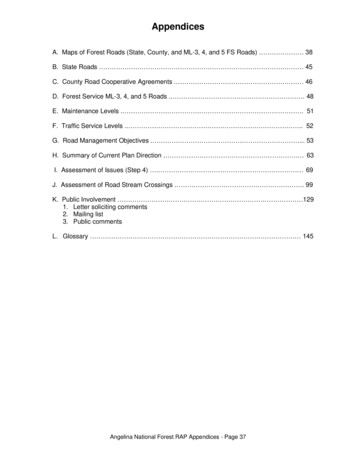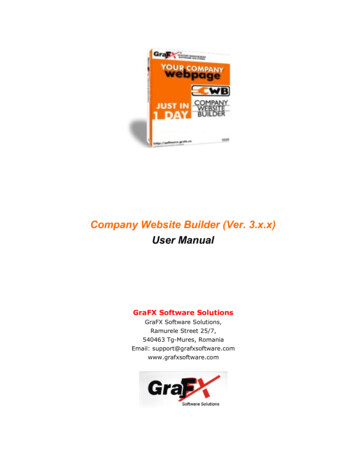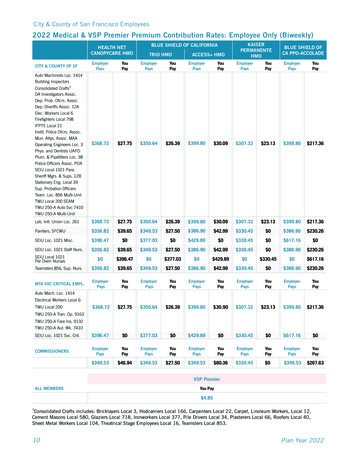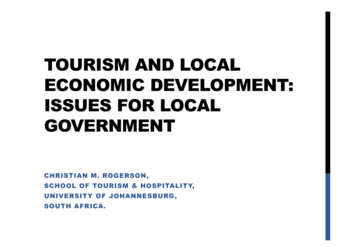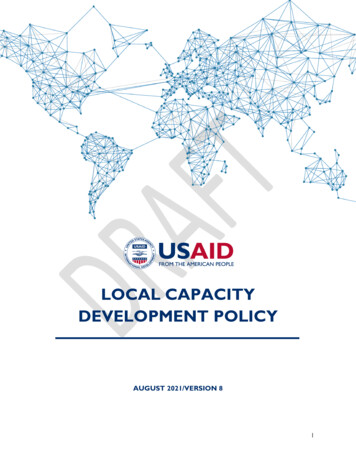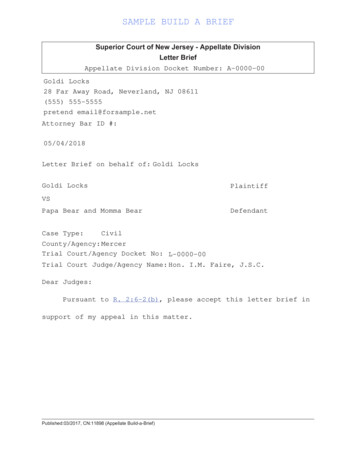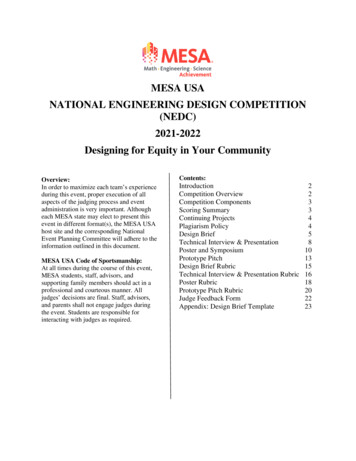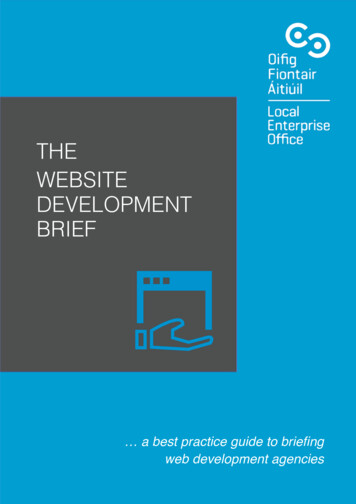
Transcription
The Website Development Brief a best practice guide to briefing web development agenciesTHEWEBSITEDEVELOPMENTBRIEF a best practice guide to briefingweb development agencies
The Website Development Brief a best practice guide to briefing web development agenciesJoint guidelines and template for business owners, to enable more effective working withweb development agencies/companies.Supported by:DISCLAIMER:Whilst every effort has been made to ensure the accuracy of the information/material contained in thisdocument, the author and the Local Enterprise Office assume no responsibility for and give no guarantees,undertakings or warranties concerning the accuracy, completeness or up to date nature of the informationprovided in this guide and do not accept any liability whatsoever arising from any errors or omissions.
The Website Development Brief a best practice guide to briefing web development agencies“Failing to prepare is preparing to fail”This guide came about because my local enterprise office encountered a very commonconcern. Their client companies were spending huge chunks of their budgets on whatoften ended up being non-functioning, incomplete or disappointing website projects. Ihave suffered this pain myself despite my computer science qualifications, and I’ve seenmany of the 200 small business owners I’ve mentored and coached fall into the sametrap. Perhaps you think you are not one of ‘those people’ but believe me, we can all findourselves in that predicament.Five years ago I established a business specifically to tackle this dilemma, so I wasdelighted to be asked to produce this guide. It affords me the opportunity to take whatI’ve learned, tested and refined and place it in the hands of as many other small businessowners as possible.Whilst a guide like this can never be totally comprehensive, it will cover the major areasthat you need to put down in writing before starting a website development project. Ihope it will be an invaluable resource that helps you formulate your brief for webdevelopment agencies/companies.It relies on the premise that to maximise your chance of success, your eventualdevelopment partner needs to know where you are now. And they need to know whereyou want to get to, what success will look like for you, and how it will be measured.Above all else, you need to make that crystal clear. If you can do that you’ll find that mostagencies/companies will be pretty good at getting you where you want to go.That is where the ‘brief’ comes in – it is the best way to capture the pertinentinformation concisely, yet comprehensively, so everyone will be singing off the samehymn sheet.If there are other members of your business whose perspective will enrich your projectbrief, and will ensure it is as comprehensive as you can make it, then it is a excellent ideato involve them.Don’t cut corners here. The problems that result will take many times longer and costmany times more to rectify. A rule of thumb us old-school software developers used wasto spend 20% of the total time/budget of any project getting the requirements welldocumented. That is my challenge to you.Patricia O’Sullivanhttps://ie.linkedin.com/in/pattiosP.S. If you want to skip sections of the suggested brief so be it, perhaps they are unsuited toyour project, but more likely it’s because you can’t be bothered to complete them. On yourhead be it! 2016 Patricia O’Sullivani
The Website Development Brief a best practice guide to briefing web development agenciesWHAT IS WEB DEVELOPMENT?Website development, also known as website design, is the process of creating a newwebsite or implementing changes to one already in use, e.g. adding a significant newsection to a live site.It is undertaken to attract and communicate with users and buyers, to enhance brandsand to launch specific campaigns.Website development can include web design, web content development (also know asthe copy, or words), client liaison, web server and network security configuration, and ecommerce development.Website development can range from developing a single page of plain text to the mostcomplex web-based internet applications, electronic businesses, or social networks. Ifyour goal is an advanced internet or mobile application then you will need to provide alittle more than these guidelines will cover, but you will find them useful nonetheless.WHY WRITE A BRIEF?There are three compelling reasons why it is worth writing a brief for EVERY projectyou commission a development agency to undertake:1. You get a better job.2. It saves you both time and money.3. The cost to you, and fee paid to the agency are fairer.1. A BETTER JOBA brief is the single most important piece of information you can prepare. It’s from thisthat everything else flows. The supplier cannot be expected to read your mind or knoweverything you do; therefore it’s essential that every effort be taken to prepare the bestpossible documentation of what is required.Giving the tightest of parameters to creative thinkers (and that’s what web developersare) will often stimulate the most creative of outcomes. You need to stimulate theircreative imagination, not restrict it. Ultimately you are buying their creativity, but youwant that creativity to be focused in the correct direction. That’s why your brief shouldbe a starting point; discovering halfway through the project that they are headed in thewrong direction inevitably leads to both sides playing ‘the blame game’.Your brief will be the platform for your business online. Hundreds, thousands orhopefully hundreds of thousands of potential customers will see it. Therefore it behovesyou to take a little time out of your busy schedule to thoughtfully describe your brand,your offerings, your market and your message. If you don’t do that then you are relyingon miracles as your strategy for success. From my experience, miracles are like buses there is never one in sight when you need it. 2016 Patricia O’Sullivanii
The Website Development Brief a best practice guide to briefing web development agencies2. SAVE TIME AND MONEYMost people would agree that sloppy briefs and moving goalposts waste both time andmoney. A clear written brief, on the other hand, can maximise the chances of getting it‘right first time, on time, on budget’.I know that ‘time pressures’ are the main reason most of you reading this will give forproducing an inadequate project brief (or no brief at all). But in fact not writing a briefto save time is a false economy, as more often it leads to re-work, or even a failedproject.You should not be using the agency to help you clarify your strategy and requirements.That is not their job and not something they are skilled at. You should have thispreparation work completed before you make an approach to them.Clearly the scale of the project will dictate the depth and complexity of your brief. Butbefore skipping over any of the suggested questions in this document, ask yourself this:are you skipping parts just because you don’t feel like answering? And is not answeringworth the risk of blowing your budget?You do not need computer or software skills to write the brief yourself. Marketing skillsare useful but not essential. Knowledge of your company, its offerings and its targetcustomers is all that really matters.3. A GOOD LONG-TERM RELATIONSHIPOne of the criticisms that marketers and software developers face is that they lackaccountability for the very significant sums of money they spend.To be fair, they operate in areas that have significant uncertainty and often trial anderror is a necessary part of the process. However, you need to act professionally byreigning them in early. The project brief is an essential start.Of course, you want results. But payment based on results is impossible without fullydefining your business objectives, your project objectives, and outlining how you plan tomeasure success. And let’s face it, without the ability to measure/demonstrateeffectiveness, you will feel you are paying too much for what you get and the agency willfeel they earned too little for their efforts.Putting an agency through the process of developing a solution repeatedly, withoutconcrete direction, wears on the relationship and is costly in wasted staff time (on bothsides).WHAT MAKES A GOOD BRIEF?There is a consensus on what makes a good brief among larger companies and theagencies they hire. It contains 3 elements:1. A written then verbal brief.2. Clarity of thought.3. Clearly defined objectives. 2016 Patricia O’Sullivaniii
The Website Development Brief a best practice guide to briefing web development agencies1. A WRITTEN BRIEFAnecdotal evidence shows that the combination of a written and verbal briefing is theideal. There are enormous benefits to starting with a written document (produced byyou, the client), which is then analysed by the agency and inconsistencies discussed byboth parties at the subsequent verbal briefing. The process of developing, discussing andagreeing the brief in this manner in itself adds value.If you encounter an agency that says “we don’t need all that stuff” or gives the impressionthat they haven’t studied your brief, then my best advice is to run in the other direction.The industry has its fair share of so called ‘experts’ who think they know your businessand your customers better than you do. They will ignore everything you tell them.Therein lies the source of the second major reason for failed web development projects(the first being your failure to prepare an adequate brief).A written brief is also vital to ensure the ‘buy-in’ of other key people in your company, inenterprise support agencies, on your board and amongst investors, suppliers and otherbusiness partners. This buy-in is essential to avoid the waste of time and resources thatcan happen when others challenge the key assumptions during or after the project build,leading to belated changes in direction. Ideally, your written brief should have the buyin of all interested parties before it is delivered to potential agency partners.2. CLARITY OF THOUGHTA good brief is not the longest or most detailed document. It’s the one whose clarity andfocus allows the agency to understand your customers, and what an effective solutionfor them will entail.“I didn't have time to write a short letter, so I wrote a long one instead.”― Mark TwainBriefs are called ‘briefs’ because they are meant to be brief! They are a summation ofyour current thinking. Too much information can confuse the process. Relevance andcontext are more important than reams of data. However, you should attach all relevantsupporting information as appendices.Your brief should contain key nuggets of information and it should set out the objectivesof your product or service, which the website development project is to play a key rolein achieving.This clarity and objectivity is not an attempt to reduce your creativity, or indeed that ofthe agency. Emotive and dramatised descriptions of your company and the key issues itfaces make it memorable and can spark off great creative thinking and solutions you hadnot considered. And it can challenge, inspire and excite those creative types in theagency you hire. 2016 Patricia O’Sullivaniv
The Website Development Brief a best practice guide to briefing web development agencies3. CLEARLY DEFINED OBJECTIVESUltimately the purpose of your brief is to get your chosen agency to provide you with asolution. But what problems should this solution solve? That is the basis of a projectbrief. Everything else is detail.Start by making sure that your objectives are crystal clear. Use concrete businessobjectives like ‘to double online revenue’ rather than woolly suggestions such as ‘toimprove brand image’. Remember that SMART acronym? Objectives should be Specific,Measureable, Achievable, Realistic and Timely and remember, every objective startswith the word ‘to’.That’s not where it ends. You need to spell out exactly how you plan to measure thoseSMART objectives. No contract that expects to pay based on results can be made to workwithout appropriate measures of performance. So, clearly defining the objectives(‘success criteria’), what that success will look like and how will it be measured is thenumber one requirement for writing a good brief.LET’S FACE FACTSMany agencies complain that the briefs they receive from clients are often inadequateand missing key information. In particular, the criteria for success and the metrics ormeasurements of that success are often completely ignored. It's also rare to find one thatprovides all the necessary market data, the full scope of the business objectives, anddiscusses the various media channels that might be used to drive people to the site.Rectifying this, or worse forcing the agency tease out and write the complete briefthemselves, requires considerable work by the agency. If they’re not getting paid toundertake this work, then why should they spend much time on it?If proper time and attention has not been given to a brief before the project starts thenthe chances of success probably equate to the chances of winning the lottery. There arehuge quantities of anecdotal evidence that show the best way to brief an agency is acombination of documentation and verbal discussion, with the documentation providedfirst and time given to allow the agency to review and ask questions.If a development company or agency you approach suggests skipping the brief becausethey know what you want, alarm bells should be ringing. You might be a small companybut this is procurement and involves a significant sum of your own and perhaps otherpeople’s money. Taking shortcuts will place you in a very unenviable position later.When you do prepare your brief, you may find that some agencies have a tendency toignore your brief and write their own, thus apparently duplicating effort and perhapseven misinterpreting your requirements. In truth they are not ignoring your brief norintentionally misinterpreting your requirements (in most cases at least).The truth is that they need to consider the project from their perspective, which will betechnology and delivery focused. If they don’t do this step then they are operating on awing and prayer and again, this is not what you want to see. They don’t have to be a bigcompany to act professionally so insist on it with whomever your chosen partner is.People who act professionally care about doing a good job, care about pleasingcustomers and care about their reputations – others think there are many fish in the seaso it doesn’t matter. Which do you want to risk your money and the future of yourbusiness on? 2016 Patricia O’Sullivanv
The Website Development Brief a best practice guide to briefing web development agenciesIf it looks like the agency’s brief is misinterpreting something, or it missed somethingkey in your brief, point it out. More often than not it was a misunderstanding or anoversight. Getting these things cleared up before a projects starts is vital, so be preparedto spend more time on these initial stages of the project than you originally planned –this is where the success of your project lies.FINAL WORDSDon’t forget you need to consider the ‘words’ (known as copy) that will appear on yourwebsite. Ideally this should be ready, or at least drafted, before you start buildinganything. If you are writing it yourself or hiring another party to prepare it then get thatmoving, or better yet completed, before starting work on the technology. To allow this tohappen you can look at other websites and prepare similarly sized ‘chunks’ of text thatthe website developers can simply paste in.Keep in mind that people don’t read long-winded websites nowadays; they consumeinformation in small chunks. So copy the approach of proven winners and don’t tryreinventing the wheel.Something I personally do is look through website templates on themeforest.net anddecide on the one or two I like best. Then I prepare the words/copy and supply sampleimages to suit my chosen templates.I then go out looking for agencies that are prepared to use the themeforest.net templatebecause I know that will save us considerable time (don’t believe anyone who tells youotherwise). That equates to saved money, which allows me to do more. Usually I willinsist on getting the template up and live with my copy and the images we chosetogether as my first milestone. At that point I know I have a website that is, presumably,bug-free and looks like it cost a fortune to design and build. Other things I want toachieve with the website come later as subsequent delivery and payment milestones.This ensures that I have something live and useful every step of the way, and that I cantest before we move on.CONCLUSIONWe have now discussed the key sections in a best practice project brief and why youshould write one. The key sections should be completed for every brief you write. Thedetail within each section will vary according to your circumstances and your projectrequirements.Generally your brief should focus on defining ‘where we are now’ and ‘where we wantto be’. It is then the job of the agency to bridge the gap between the two. How they goabout that is their specialism, or it should be, and it should happen within the context ofyour ‘what we are doing to get there’ description.A crucial point is to be as explicit as possible about the measures of success, i.e. “how wewill know we’ve arrived”. And then there are the final operational details about projectmanagement and practicalities. So enough talk, let’s get started 2016 Patricia O’Sullivanvi
The Website Development Brief a best practice guide to briefing web development agenciesTEMPLATEWEBSITE DEVELOPMENTPROJECT BRIEF
The Website Development Brief a best practice guide to briefing web development agenciesCONTNETS1. PROJECT CONTEXT12. WEBSITE REQUIREMENTS53. COMPANY OVERVIEW74. SPECIAL FUNCTIONALITY85. GRAPHIC DESIGN106. WEBSITE ANALYTICS127. WEBSITE ADMINISTRATION148. ADDITIONAL DETAILS16
The Website Development Brief a best practice guide to briefing web development agencies1. Project ContextThe Project Context (also know as Context, Setting or Prerequisites) is thecircumstances, facts or events that influence the project.They explain the general idea and key prerequisites of the project, includingproblems to be addressed, objectives, desired results, and parties interested inand/or impacted by the project. It also describes the financial elements,resources, timelines and other possibilities and limitations of the project.The purpose of this section is to give an overview of the project, to provide initialimpressions about the project and to initiate the planning process. It does notcover specific requirements, methods to be used or any other more detailedinformation.What is the main objective/outcome of your project?Let the provider know what you are aiming to achieve from the project and how you see itsend results. Clarity here goes a long way to prevent project failure, misunderstandings orincorrect expectations.What challenge/opportunity gave rise to the project?It is helpful to the provider to understand where you are coming from. Are you facingcompetitive challenges, launching a new product, seeing a downturn in revenues, ormeasuring a potential opportunity?For example, ‘our old website was hacked so we need something new that is secure’; ‘ournew Chairman of board is a marketing guru and wants a whole new image’; ‘we arelaunching new products and thought this would be a good time up replace/update the oldwebsite’. 2016 Patricia O’Sullivan1
The Website Development Brief a best practice guide to briefing web development agenciesWhat is the budget for project?This is a thorny subject. At the very least you need to tell the provider if your budget for thisproject has been approved, if it will only be approved after their quotation is received, or ifit will only be approved when something else happens e.g. grant approval.You may be uncomfortable stating your budget upfront believing that the webdevelopment agency will simply ask for it all. That is understandable, but put the shoe onthe other foot for a moment. If the tables were turned would you not want to give your newclient the best possible result you could within their budget? Would you not want to doeverything you could to demonstrate they can trust you and that you are genuinely thereto help them?Despite what we might think sometimes, that is the norm in business. Of course there arealways greedy people, but if you have prepared a detailed brief, the questions they fail toask and their proposed solution will usually reveal their true character. Not demonstratingtrust in the suppliers you approach is a little disrespectful at best. At worst, it can lead totime wasted and disappointing results.Overall, it is better if you can supply an indication of budget from the outset. A techniqueoften used is ‘scenario budgeting’. For instance, you might supply one or more hypotheticalbudgets e.g. ‘What would your recommendations on budgets of x, y, and z be?’An upfront understanding of budget will allow the agency to accurately describeanticipated results. It also affords them the opportunity to consider different approachesand different sequences that allow them to provide you with the best possible outcome foryour budget. Remember ‘best’ is not ‘most’; it is what achieves your objectives successfully.Alternatively, you can request the agency’s recommended budget to achieve your set ofgiven measurable objectives. More often than not however this wastes everyone’s timeannoys people when you later come back to advise on a realistic budget.Are subcontractors allowed?Many providers use outside contractors they trust for certain project activities. Let themknow if you have any constraints here. 2016 Patricia O’Sullivan2
The Website Development Brief a best practice guide to briefing web development agenciesAre there project documentation requirements?Let the provider know if you need any project documentation (e.g. status update, user’smanual, etc.) and/or presentations prepared for the project.Do you have a firm deadline for project delivery?Tell the provider if there are any specific dates or events that constrain the project’stimeframe.Will there be revisions during the project?Do you anticipate clarifications/revisions during the project? If yes, explain what and why. 2016 Patricia O’Sullivan3
The Website Development Brief a best practice guide to briefing web development agenciesAny other practicalities?Is this website part of a media strategy/plan? Explain how it ties into these other activities;are there any legal constraints in your market? Do you have a set of brand guidelines thatmust be complied with? Are you receiving support from a source that requires the use oftheir logo on the site? Where will the provider obtain it and any guidelines associated withits use?Who is responsible for approval/acceptance?Who in your business has the authority to sign off the work that the agency produces. Howwill they review, test staged deliveries, and sign each off as complete?Will you need support after completion?Is on-going support required from the agency following completion of the project tomaintain the website (e.g. security upgrades, etc.) and/or to make occasional changes tothe site? 2016 Patricia O’Sullivan4
The Website Development Brief a best practice guide to briefing web development agencies2. Website RequirementsThis is a detailed explanation (also known as Project Needs or ProjectSpecifications) of what is needed or demanded from the project. In essence it iswhere you want to be post-project.This section is used to define the business needs, the problems to be addressed,the implementation methods and approaches to be applied, and your desired goalfor the project. The goal should be set in the context of your overall business andmarketing plan, as well as what you believe will be achievable by this specificproject within your proposed timeframe and budget.This definition of requirements is the most crucial part of the project. Incorrect,inaccurate, or excessive definition of requirements may result in schedule delays,wasted resources, or your dissatisfaction with the final outcome.Every website is different but a single-minded and measurable objective is usuallya pre-requisite for success. Typical objectives are to increase sales by a factor of‘x’, to increase usage by ‘y’, awareness, image, reputation, profitability, customerprofile, shareholder value, response levels, etc.What website development services do you need?What kind of website design services are you looking for? A brand new first time website, acomplete re-design of an existing website, maintenance of or small upgrades/correctionsto an existing website?What are the goals of the website?What are your specific short, medium and long-term goals for the website? 2016 Patricia O’Sullivan5
The Website Development Brief a best practice guide to briefing web development agenciesHow will the website be structured?What pages do you have in mind for your website? For example, a home page, productspage and individual product pages, about us, contact us. How many overall pages with howmany different structures?Do you require optimization for mobile devices?Would you like your website to be optimised for mobile users in any specific way or will atypical device and orientation responsive site suffice?How will you measure success?Describe the form success and failure in this project will take. How will success bemeasured? Who will measure it? Are there specific ‘objective’ measurements that can beused? How will payments be tied to those measurements?Remember that your website is only part of the marketing and communications strategyfor your business. It is a step on the path of a longer journey. It cannot achieve miracles inand of itself; it merely provides progress towards your bigger and longer-term companygoals and should be measured accordingly. 2016 Patricia O’Sullivan6
The Website Development Brief a best practice guide to briefing web development agencies3. Company OverviewThe Company Overview (also referred to as Product & Market) should contain thefollowing information, where relevant: product or service description (includingkey attributes and benefits); manufacturing or service delivery; distributionchannels; market size (volume and value); customer usage data if available; yourcompany brand’s positioning; its history of brand communications, etc.This section is used to define a more specific context for the project and todetermine the most suitable approaches and methods to be used.Above all, remember that despite every website being different, they are allintended to elicit some form of response from a particular group of people. Yourtarget groups should be clearly defined and prioritised as accurately as possible use demographics, lifestyle, product usage, attitudes, etc.Equally and perhaps more important are the insights that you have about thesetarget groups. These insights can be used as a platform to build on and as a guidefor the various decisions that need to be made, in a way that will create thedesired reaction.What is the website’s primary audience?Define your website’s target audience. Include as much detail as possible. If your websiteaudience is different from your current customer/user/ purchaser profile describe whatthe difference is. For example, parents, particularly mothers of children aged 0-5 years;retirees in the 55-65 age group.How do you want people to perceive your website?Write down 3-5 adjectives that describe how a user should perceive your site. For example,conservative, progressive, friendly, formal, professional. 2016 Patricia O’Sullivan7
The Website Development Brief a best practice guide to briefing web development agencies4. Special FunctionalityThe Special Functionality (or Additional Functionality) section of the brief is anoverview of specific features that you might wish to have on your website, andthat might increase the budget and time for the project.It is used to plan and budget for features such as an online shop, customer portal,member interaction, networking, etc.Planning website functionally helps to see how your website can become morethan just a platform for promotion and selling. With time, it can become a tool tobuild relationships with your customers and to improve your service delivery.Do you need a feedback form?Would you like to include a feedback form capturing some user details on your website?Do you require eCommerce functionally?Do you require an online store on your website?Do you require a member’s area?A member’s area provides members with specific tools and resources that are not availableto non-members. Would you like to have a member’s area on your website? 2016 Patricia O’Sullivan8
The Website Development Brief a best practice guide to briefing web development agenciesDo you require a search facility?Would you like to have a search facility on your website?Any other tools / features?Would you like to include any specific tools in the website? For example: A Content Management System (CMS) to allow you or others to quickly and easilymanage, modify, edit, upload/remove/replace the information on the website.The ability to change special offers on products.Shopping cart functionality to enable a site visitor to browse and add products totheir cart and later to complete the purchase.An interactive online quotation builder to enable site visitors to select productsthey want and to get a quote based on various bulk quantities.Training/online learning functionality to show videos and to supply trainingmaterials.Community features or a forum to enable users to interact with each other.Other features – what and where can the web develop
Website development can include web design, web content development (also know as the copy, or words), client liaison, web server and network security configuration, and e-commerce development. Website development can range from developing a single page of plain text to the most




